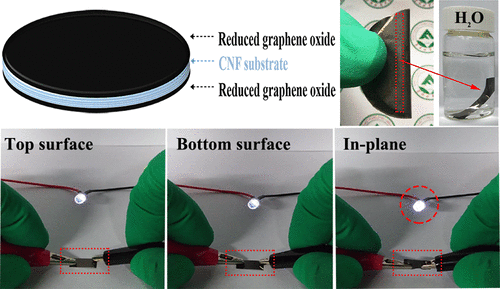当前位置:
X-MOL 学术
›
ACS Sustain. Chem. Eng.
›
论文详情
Our official English website, www.x-mol.net, welcomes your
feedback! (Note: you will need to create a separate account there.)
Enhanced Electrical Conductivity of Cellulose Nanofiber/Graphene Composite Paper with a Sandwich Structure
ACS Sustainable Chemistry & Engineering ( IF 7.1 ) Pub Date : 2018-01-21 00:00:00 , DOI: 10.1021/acssuschemeng.7b02683 Minjie Hou 1, 2 , Miaojun Xu 1 , Bin Li 1, 2
ACS Sustainable Chemistry & Engineering ( IF 7.1 ) Pub Date : 2018-01-21 00:00:00 , DOI: 10.1021/acssuschemeng.7b02683 Minjie Hou 1, 2 , Miaojun Xu 1 , Bin Li 1, 2
Affiliation

|
A novel conductive paper based on cellulose nanofiber (CNF) and reduced graphene oxide (RGO) with a sandwich structure was successfully prepared through step-by-step vacuum filtration followed by a chemical reduction process in which a CNF layer is sandwiched between two thin RGO layers. This unique design strategy not only provides a highly conductive network for its surface but also maintains the structural integrity of CNF. The sandwich-structured paper exhibits a significantly conductive anisotropy, and the in-plane electrical conductivity is drastically enhanced as 4382 S m–1 with only 4 wt % RGO, whereas it is insulating along the cross-plane direction. This can be attributed to the RGO layers at the top and bottom surface connected in parallel. This high electrical conductivity is greatly superior to most of the cellulose/graphene composite papers obtained by conventional blending processes. Compared with the similar layer-by-layer assembly technique, the present method is more feasible and time saving. Moreover, the sandwich-structured paper shows excellent mechanical strength and good flexibility, which may facilitate its applications in future flexible electronics.
中文翻译:

具有夹心结构的纤维素纳米纤维/石墨烯复合纸的增强的电导率
通过逐步真空过滤,然后通过化学还原工艺将CNF层夹在两个薄RGO之间,成功制备了一种基于纤维素纳米纤维(CNF)和还原型氧化石墨烯(RGO)并具有夹心结构的新型导电纸。层。这种独特的设计策略不仅为其表面提供了高度导电的网络,而且还保持了CNF的结构完整性。夹心结构的纸表现出明显的导电各向异性,并且当4382 S m –1时,面内电导率显着提高仅含有4 wt%的RGO,而它在横断面方向上却是绝缘的。这可以归因于平行连接的顶面和底面的RGO层。这种高电导率大大优于通过常规混合工艺获得的大多数纤维素/石墨烯复合纸。与类似的逐层组装技术相比,该方法更加可行,省时。此外,夹心结构的纸显示出优异的机械强度和良好的柔韧性,这可能有助于其在未来的柔性电子产品中的应用。
更新日期:2018-01-21
中文翻译:

具有夹心结构的纤维素纳米纤维/石墨烯复合纸的增强的电导率
通过逐步真空过滤,然后通过化学还原工艺将CNF层夹在两个薄RGO之间,成功制备了一种基于纤维素纳米纤维(CNF)和还原型氧化石墨烯(RGO)并具有夹心结构的新型导电纸。层。这种独特的设计策略不仅为其表面提供了高度导电的网络,而且还保持了CNF的结构完整性。夹心结构的纸表现出明显的导电各向异性,并且当4382 S m –1时,面内电导率显着提高仅含有4 wt%的RGO,而它在横断面方向上却是绝缘的。这可以归因于平行连接的顶面和底面的RGO层。这种高电导率大大优于通过常规混合工艺获得的大多数纤维素/石墨烯复合纸。与类似的逐层组装技术相比,该方法更加可行,省时。此外,夹心结构的纸显示出优异的机械强度和良好的柔韧性,这可能有助于其在未来的柔性电子产品中的应用。











































 京公网安备 11010802027423号
京公网安备 11010802027423号